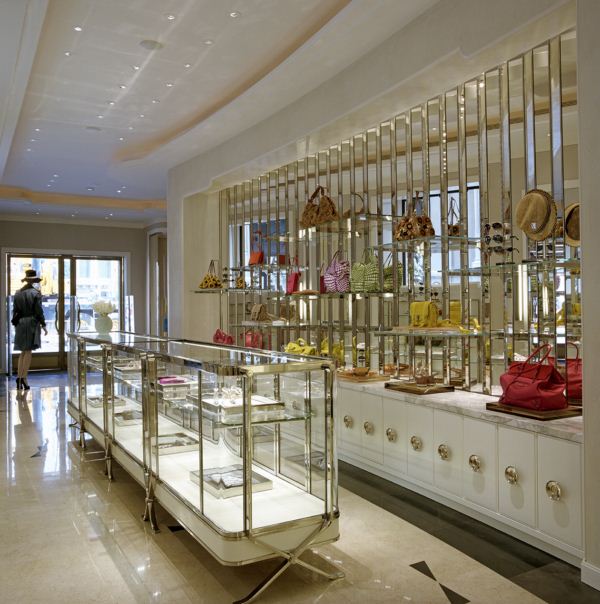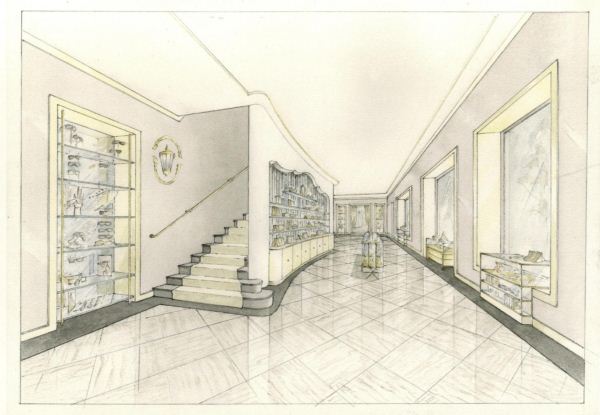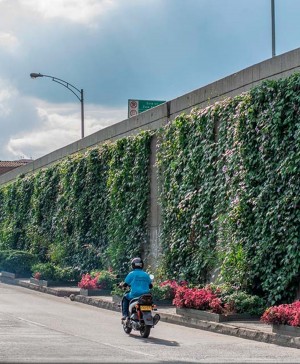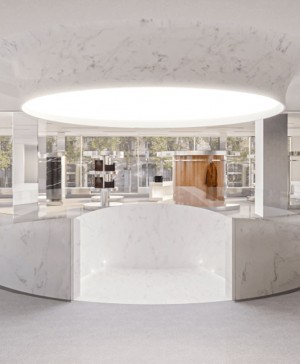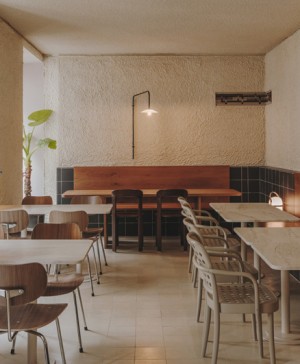The new Santa Eulalia designed by William Sofield. Renovated in Barcelona to dazzle the world.
 It might seem like it’s Fifth Avenue, but we are on the Paseo de Gracia in Barcelona. Some of the decorative details could remind you of the Art Deco aesthetics of the Roaring 20s, but the new Santa Eulalia is a shop boldly thought out and designed for the nineteenth century. Recently renovated by the American architect William Sofield, the classic establishment that for more than 150 years has dressed the Catalan high bourgeoisie, is now a cosmopolitan store proud of its teeming glamour. It has nothing to envy the best shops on the planet.
It might seem like it’s Fifth Avenue, but we are on the Paseo de Gracia in Barcelona. Some of the decorative details could remind you of the Art Deco aesthetics of the Roaring 20s, but the new Santa Eulalia is a shop boldly thought out and designed for the nineteenth century. Recently renovated by the American architect William Sofield, the classic establishment that for more than 150 years has dressed the Catalan high bourgeoisie, is now a cosmopolitan store proud of its teeming glamour. It has nothing to envy the best shops on the planet. This was an old dream of its owners, Luis Sans and his wife Sandra Domínguez. Thanks to the complete renovation of the building that housed the emblematic establishment on Passeig de Gràcia 93, they’ve seen it come true. The original façade of the building has been kept, but the shop has been completely reinvented, creating a new concept more suited to the current times.
This was an old dream of its owners, Luis Sans and his wife Sandra Domínguez. Thanks to the complete renovation of the building that housed the emblematic establishment on Passeig de Gràcia 93, they’ve seen it come true. The original façade of the building has been kept, but the shop has been completely reinvented, creating a new concept more suited to the current times.

The new premises – over 2,000 square meters of it – houses larger spaces for its collections for men, women and accessories, but also new areas like an ephemeral pop-up store, a cafeteria and a terrace.
 The ground floor, devoted to the Men’s Collection, retains the classical style that has made Santa Eulalia an emblem of quality. The tailoring service is also here, the undisputed trademark of this century old family business. As a tribute to tradition, there is a secluded area where, through the windows, you can see the tailors at work.
The ground floor, devoted to the Men’s Collection, retains the classical style that has made Santa Eulalia an emblem of quality. The tailoring service is also here, the undisputed trademark of this century old family business. As a tribute to tradition, there is a secluded area where, through the windows, you can see the tailors at work.
 The first floor is a new surprise for most fashionistas of the city. In it the Women’s collection, improved and expanded with more accessories and new brands by Sandra Domínguez, shines through well-kept glass cabinets, bevelled mirrors. There are new counters in a retro style and velvet capitonné sofas. There is no end to the inexorable attention to detail – worthy of the select female clientele of Santa Eulalia.
The first floor is a new surprise for most fashionistas of the city. In it the Women’s collection, improved and expanded with more accessories and new brands by Sandra Domínguez, shines through well-kept glass cabinets, bevelled mirrors. There are new counters in a retro style and velvet capitonné sofas. There is no end to the inexorable attention to detail – worthy of the select female clientele of Santa Eulalia.

 In addition, we find a small and exquisite café with terrace, decorated with a flair inspired by the Santa Eulalia posters of the 1920s and 30s. The bar has been recovered from an old bar in Toulouse. The interior furniture is made of Thonet chairs, upholstered with a re-issue of a historic Liberty print, and tables of engraved marble with iron feet. On the adjoining garden terrace are Tolix metal chairs, designed in 1927. In short, an exquisite small corner where you can enjoy a selection of light meals, and sweet or savoury snacks any time of day, exclusively created by the chef Sylvia Quintero.
In addition, we find a small and exquisite café with terrace, decorated with a flair inspired by the Santa Eulalia posters of the 1920s and 30s. The bar has been recovered from an old bar in Toulouse. The interior furniture is made of Thonet chairs, upholstered with a re-issue of a historic Liberty print, and tables of engraved marble with iron feet. On the adjoining garden terrace are Tolix metal chairs, designed in 1927. In short, an exquisite small corner where you can enjoy a selection of light meals, and sweet or savoury snacks any time of day, exclusively created by the chef Sylvia Quintero.
Some of the decorative details, like the Art Deco logo on the facade, created in 1926, or the neon light located above the entrance doors from 1941, have combined smoothly with the new corporate identity created by the studio Mario Eskenazi (National Award Design 2000). Two Barcelona chairs upholstered in yellow and located at the entrance, in addition to the giant suspension glass lamps of the façade, designed by Miguel Milá, also pay a heartfelt tribute to the history of design in Barcelona.
About the project by William Sofield
According to Luis Sans, owner of the shop: “from the beginning we knew that for such a large project we needed an architect with extensive experience in high level fashion boutiques. William Sofield has designed more than 800 all over the world, for brands like Gucci, Bottega Veneta, Yves Saint Laurent, Boucheron or Tom Ford. Combining the history with the present is not easy, but he has successfully achieved it, for instance in the Soho Grand Hotel in Manhattan. I think he has achieved a modern and comfortable atmosphere of high quality, by linking old and contemporary elements”.








